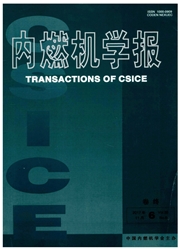

 中文摘要:
中文摘要:
考虑到氮闭环控制中NH3传感器成本高的问题,针对基于氮氧化物(NOx)传感器的尿素选择性催化还原(Urea—SCR)系统氨闭环控制策略进行了研究,以Matlab/Simulink软件为仿真平台建立了前馈控制模型、反馈控制模型、催化器模型和NOx传感器模型;考虑到NOx传感器对NH3的交叉敏感特性,通过扩展卡尔曼滤波(EKF)算法,可根据NOx传感器信号对催化器下游NH,泄漏量进行估计;在3个典型工况下采用不同的尿素喷射量进行试验,根据试验数据用非线性最小二乘法对催化器模型进行了参数辨识;在欧洲瞬态测试循环(ETC)下进行了试验,并与模型仿真结果进行对比.结果表明:模型能较好地预测催化器下游NO排放和NH3泄漏情况,且该控制策略在仿真和试验条件下均能将催化器下游NO排放控制在2g/(kW·h)以下,NH3体积分数控制在9×10-6左右.
 英文摘要:
英文摘要:
Due to the high cost of NH3 sensor in NH3-based closed-loop control, NH3-based closed-loop control strat- egy in the urea-SCR system based on NOx sensor was investigated. The feedforward control model, feedback control model, catalyst model and NOx sensor model were established. Owing to the phenomenon of NH3 cross-sensitivity of NOx sensors in the urea-SCR system, the extended Kalman filter (EKF) was utilized to estimate NH3 leakage. The test data, obtained by testing in three typical operating conditions at different urea dosages, were used for identifying parameters of catalyst model through nonlinear least square method. Comparison of the computer simulation and the engine bench test on the base of ETC operating cycle shows that the simulation model can effectively predict NO emis- sion and NH3 leakage downstream of the catalyst converter. Meanwhile, the proposed control strategy can control the NH3 leakage within a limitation of around 9 × 10-6 and the NO emission less than 2 g/(kW h).
 同期刊论文项目
同期刊论文项目
 同项目期刊论文
同项目期刊论文
 期刊信息
期刊信息
